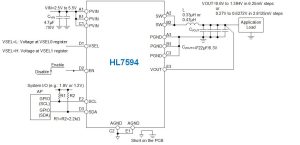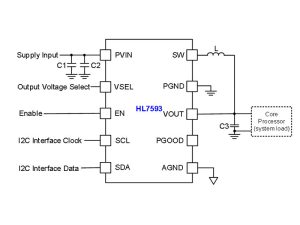Both run from 2.5 to 5.5V, and are available in multiple variants that affect output characteristics.
- HL7593 can produce 0.600 to
1.394V in 6.25mV steps - HL7594 can produce either 0.600 to 1.394V in
6.25mV steps, or 0.27V to 0.6272V in 2.8125mV steps
 “A wide range of output capacitors can be used to optimize Vout stability during load transients, and inductors from 0.33µH to 0.47µH may be used without affecting loop stability,” according to the company.
“A wide range of output capacitors can be used to optimize Vout stability during load transients, and inductors from 0.33µH to 0.47µH may be used without affecting loop stability,” according to the company.
Looking into the data briefs, the HL7593 actually pushes the upper bound to 1µH “without affecting loop stability”.
For dynamic voltage scaling with, the company defines the HL7593 programmable voltage slew rate as “0.5mV to 64mV/step” in its brief. Electronics Weekly has requested more information on this – watch this space.
At higher loads, the devices operate with 2.4MHz pulse width modulation.
To maintain conversion efficiency at moderate to light loads, pulse frequency modulation is available – 94 variants always default to this, some 93 variants do too. Quiescent current is typically 48µA between switchin gin PFM mode, and shut-down consumption is <1µA.
On the subject of variants, the main difference between variants of both devices is the output voltage they default to when powered-up – many parameters can be altered once I2C communication is established. All of them can be programmedthe
Both devices include output voltage remote sensing to set the voltage at the load’s terminals – without affecting control loop stability, according to Halo.
Packaging is 15bump 2 x 1.2mm WLCSP
point-of-load applikcations are foreseen with processors, memory, hard drives and in mobile devices.

